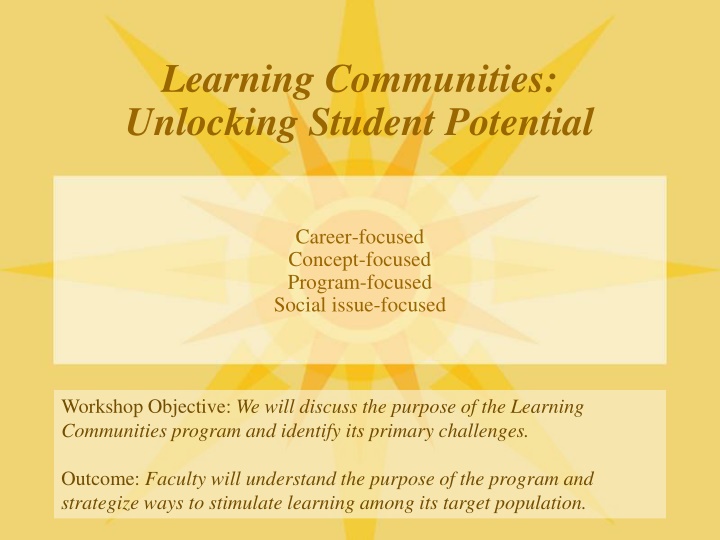
Unlocking Student Potential through Learning Communities Exploration
Discover the impact of Learning Communities in unlocking student potential, addressing challenges, and strategizing ways to enhance academic and social support. Engage in discussions, explore program outcomes, and analyze data trends to optimize learning community success.
Download Presentation

Please find below an Image/Link to download the presentation.
The content on the website is provided AS IS for your information and personal use only. It may not be sold, licensed, or shared on other websites without obtaining consent from the author. If you encounter any issues during the download, it is possible that the publisher has removed the file from their server.
You are allowed to download the files provided on this website for personal or commercial use, subject to the condition that they are used lawfully. All files are the property of their respective owners.
The content on the website is provided AS IS for your information and personal use only. It may not be sold, licensed, or shared on other websites without obtaining consent from the author.
E N D
Presentation Transcript
Learning Communities: Unlocking Student Potential Career-focused Concept-focused Program-focused Social issue-focused Workshop Objective: We will discuss the purpose of the Learning Communities program and identify its primary challenges. Outcome: Faculty will understand the purpose of the program and strategize ways to stimulate learning among its target population.
If you want to build a ship, dont drum up people to collect wood and don t assign them tasks and work, but rather teach them to long for the endless immensity of the sea Antoine de Saint Exup ry Target population: historically underserved and first-year students Program purpose: assist students in reaching their academic goals by building a sense of community, social support, and student engagement
Program Learning Outcomes Students will: engage in learning through facilitated faculty and peer interaction collaborate with peers who share similar personal and/or career interests appreciate diversity in people, cultures, and experiences identify and choose appropriate academic and career support services demonstrate confidence in their academic abilities
In groups of 2-3: In a previous semester, how did you make your learning community successful? If new to this program, what would you do to make your learning community successful? (5 minutes)
Learning Communities Studies According to studies, learning communities tend to retain higher numbers of students and result in greater student completion rates. In groups of 2-3: What is your reaction to this statement? Does it surprise you? Why or why not? (5 minutes)
Learning Communities Data Examine the SJDC Learning Communities course success and retention rates from 2011-2012 (handout available on Docushare). In groups of 2-3: What trends do you see? What high points/low points? What does data show in terms of the program s purpose?
The LC Paradox Based on recent data, many SJDC learning communities are NOT retaining higher numbers of students and resulting in greater completion rates. Thus, the program overall is not helping our historically underserved students meet their academic goals to the extent that we would prefer. In groups of 2-3: List five or more reasons behind this paradox (i.e. reasons why the program isn t as successful as we think it should be). Next, narrow your list to reasons that we, as faculty, can control. Cross out reasons that are beyond our control.
Fueling Student Success Which of these issues can we immediately address to better serve our target population and increase student completion rates?
Debrief and Next Steps What questions remain for you regarding the purpose of the Learning Communities program and its challenges? Contemplate what you can do to better serve your learning community students.
Thanks for being part of the Learning Communities program!
